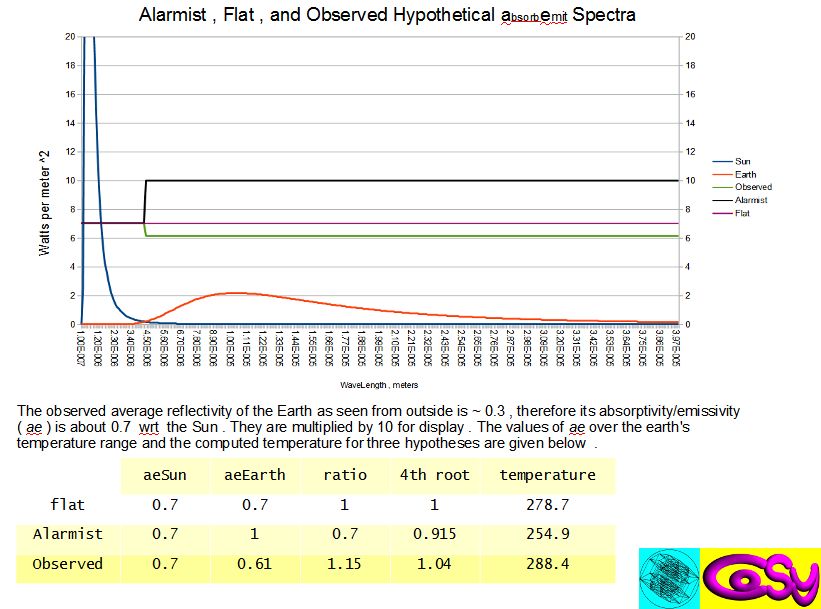|
In response to : @KarolinaHa on CoSy ComputationalEarthPhysics
That's what I've tried to indicate in this image .

I think it would be much clearer if I used an actual , or at least more natural looking spectrum like the measured ToA spectrum in addition to those hypothetical step functions .
And yes to your second paragraph . It's the correlation of the object's aε weights with the thermal spectra which shifts the equilibrium up or down . Ie: the ratio of the dot products .
Third paragraph : Right ! ( summing across all frequencies ) .
4th : No , the 3 percent cannot be explained by color . In fact , I think it's rather clear that the 0.7 short % long wave ratio , while uselessly crude when measured spectra are available , is in the ball park . In CoSy :
Only later did I appreciate the obvious cause of the ` lapse gradient was the non-optional trade-off of gravitational potential energy with kinetic keeping total energy constant . See my opening comments at http://cosy.com/#PlanetaryPhysics , and the box :
I'm past doing solo acts , so while I'd do all I could to support someone implementing the quantitative relationships in CoSy , CoSy itself is my overriding priority . ( and the main use there is the everyday business of life , mainly diary and accounts . )
20200320Thank you for bringing this over here to cosy.com/Science/ComputationalEarthPhysics.html . I haven't used the Disqus widget in a long time , and it seems to me to have degraded . Thus I'm posting this as a page at
I'm afraid everything I've ever done is a bit hard to follow 😞 .
Responding to questions like this is very useful . ( And boy this page needs a cleanup ).
The
Planck function , ie: thermal radiation function has just 1 parameter ,
temperature , and it produces a family of power spectra . Here's a
graph of the Planck power spectra for the ~ 5800K of the Sun and the ~
300K of the Earth : 
That's what I've tried to indicate in this image .

I think it would be much clearer if I used an actual , or at least more natural looking spectrum like the measured ToA spectrum in addition to those hypothetical step functions .
And yes to your second paragraph . It's the correlation of the object's aε weights with the thermal spectra which shifts the equilibrium up or down . Ie: the ratio of the dot products .
Third paragraph : Right ! ( summing across all frequencies ) .
4th : No , the 3 percent cannot be explained by color . In fact , I think it's rather clear that the 0.7 short % long wave ratio , while uselessly crude when measured spectra are available , is in the ball park . In CoSy :
0.7 0.25 2_f ^f |>| 0.91The point of my Heartland talk is that the same calculation for Venus , whose surface is ~ 2.25 the gray body temperature in its orbit , is quantitatively absurd .
R0 278.6 _f *f |>| 254.83
Only later did I appreciate the obvious cause of the ` lapse gradient was the non-optional trade-off of gravitational potential energy with kinetic keeping total energy constant . See my opening comments at http://cosy.com/#PlanetaryPhysics , and the box :
All these equations can be worked out , and I think have been by various people , but not brought together into one computable whole .
Newton's Law of Gravity which explains how much faster satellites go in lower orbit also explains how much faster molecules go at the bottoms of atmospheres and thus quantitatively explains the temperature profiles of all planets whatever their atmosphere including the ~ 33c warmer the bottom of our atmosphere is than our radiative balance with the Sun .
- Particles moving "up" in a gravitational field slow down , ie: cool ;
- Those moving down speed up , ie: heat .
The GHG paradigm , excluding the Law of Gravity in violation even of conservation of energy , being false , has thus never presented a testable equation quantifying their asserted spectral "trapping" nor an experimental demonstration of it .
I'm past doing solo acts , so while I'd do all I could to support someone implementing the quantitative relationships in CoSy , CoSy itself is my overriding priority . ( and the main use there is the everyday business of life , mainly diary and accounts . )
--
 |
|
||||
